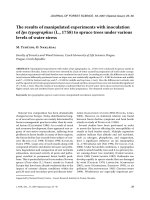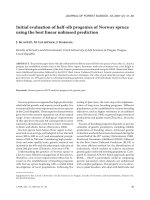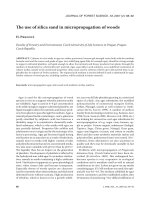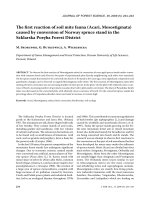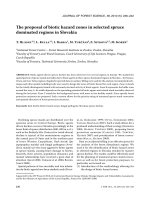Báo cáo lâm nghiệp: "The influence of irradiation on the behaviour and reproduction success of eight toothed bark beetle Ips typographus (Coleoptera: Scolytidae)" doc
Bạn đang xem bản rút gọn của tài liệu. Xem và tải ngay bản đầy đủ của tài liệu tại đây (456.52 KB, 7 trang )
J. FOR. SCI., 53, 2007 (Special Issue): 31–37 31
JOURNAL OF FOREST SCIENCE, 53, 2007 (Special Issue): 31–37
e influence of irradiation on the behaviour and
reproduction success of eight toothed bark beetle
Ips typographus
(Coleoptera: Scolytidae)
M. T
1
, J. V
2
1
Faculty of Forestry and Wood Sciences, Czech University of Life Sciences Prague,
Prague, Czech Republic
2
Department of Forest Protection and Game Management, National Forest
Centre – Forest Research Institute in Zvolen, Research Station Banská Štiavnica, Slovakia
ABSTRACT: Irradiation experiments on Ips typographus (L., 1758) with doses of 15 and 30 Gy (cobalt 60) were con-
ducted in 2006. e effect of irradiation on the mating behaviour and reproduction success of the bark beetle has been
evaluated in rearing experiments in the laboratory. e effect of treatment on basic rearing parameters – (a) galleries
per log, (b) mating chambers per log, (c) galleries with mother tunnels, (d) galleries with larvae tunnels, (e) mother
tunnels – was not statistically significant – (a) F = 0.609, d.f. = 4, P = 0.560; (b) F = 1.883, d.f. = 4, P = 0.194; (c) F =
1.322, d.f. = 4, P = 0.303; (d) F = 0.373, d.f. = 4, P = 0.697; (e) F = 0.519, d.f. = 4, P = 0.608, ANOVA. e comparison of
detailed rearing parameters showed statistically significant differences in the size of the mating chamber only, when
both irradiated variants produced a larger mating chamber than did the control beetles (F = 5.113, d.f. = 4, P = 0.025,
ANOVA). Irradiation changed the behaviour of males, so that they moved significantly faster than males in control
(n = 18, P = 0.001, t-test), and 15 Gy irradiated males were significantly more successful in competition for females
than 30 Gy irradiated males (F = 8.067, d.f. = 6, P = 0.015, ANOVA). In contrast, the number of eggs produced by
females was significantly lower in the 15 Gy (F = 5.13, d.f. = 17, P = 0.029, ANOVA) and 30 Gy (F = 5.292, d.f. = 17,
P = 0.028, ANOVA) irradiated variants as compared to the control and, the number of hatched eggs was significantly
higher in the control group than in the 15 Gy (F = 5.415, d.f. = 17, P = 0.025, ANOVA) and 30 Gy (F = 6.916, d.f. = 17,
P = 0.014, ANOVA) variants. e results are discussed below.
Keywords: Ips typographus; irradiation; sterile insect technique; reproduction success
Supported by the International Atomic Energy Agency in Vienna, Project No. 12400 to National Forest Centre – Forest Research
Institute in Zvolen, Slovakia.
e use of the sterile insect technique (SIT) for
suppressing pest populations was proposed ini-
tially by K (1955). Since that time the ef-
fectiveness of using the sterile insect technique
(SIT) has been demonstrated by various models
and applied operationally and successfully against
many insect species. is technique is based on
flooding the feral population with large numbers
of sterile individuals (mostly males). When there is
a high flooding ratio of sterile over feral individu-
als in the field, and the sterile individuals are fully
competitive, the probability of mating of females by
fertile males declines. However, to be effective the
released mass-reared and sterile males have to suc-
cessfully transfer their sperm carrying dominant
lethal mutations to a large majority of females in
the target population.
e treated areas may largely be influenced by
the migration of non-sterile males. As a result, SIT
is only effective when applied on an area-wide basis
addressing the pest simultaneously over large for-
est areas. e effectiveness of integrating compat-
ible pest control methods is significantly increased
by coordinated implementation over larger con-
32 J. FOR. SCI., 53, 2007 (Special Issue): 31–37
tiguous areas to address whole target pest popula-
tions (K 1979). is area-wide integrated
pest management (IPM) approach to pest man-
agement is gaining acceptance for some key insect
pests (T 2000). e case for an area-wide IPM
approach arises for these key pests as they cannot
be effectively controlled at the local forest level
without the systematic use of insecticides that dis-
rupt natural enemies and cause a negative impact
to ecosystems.
Among biologically-based methods, the SIT is the
most target-specific and non-disruptive method.
Unlike some other biologically based methods it is
species-specific, does not release exotic agents into
new environments and does not even introduce
new genetic material into existing populations as
the released organisms are not self-replicating.
e efficiency of this method depends on several
parameters which have to be evaluated prior to field
release of irradiated insect species, I. typographus
males in this particular case. One of the most im-
portant parameters is an optimal irradiation dose.
Too high dose may cause the mortality of males,
whereas too low dose may lead to their incomplete
sterility. e irradiation may also change the be-
haviour of males and, if the behaviour is not com-
petitive with that found in wild males, the release
of sterile males may have a negligible effect. An ad-
ditional important parameter is the sub-sterilizing
dose in F1 generation which guarantees a higher ef-
ficiency of method in F2 generation.
us, the goals of this study were as follows:
– To assess the effect of sub-sterilizing doses (15 and
30 Gy) applied to emerging I. typographus males
on F1 generation of the bark beetle, particularly
with regard to their reproduction success.
– To analyze mating behaviour in males irradiated
with different doses (15 and 30 Gy) when com-
peting for non-irradiated females.
MATERIAL AND METHODS
We established continual rearing of I. typogra-
phus adults in June 2006. e beetles were collect-
ed in the Štiavnické vrchy Hills (GPS co-ordinates:
N: 48°28.175'; E: 18°52.241'), West Carpathians,
Central Europe, in their endemic populations in
spruce monocultures, where the parasitism and
proportion of pathogens are usually low. Infested
logs were brought to the laboratory and put into
the light boxes. e hatched and emerged indi-
viduals were captured daily in plastic jars and kept
in refrigerator. After several days, when sufficient
number of individuals was stored, we prepared sev-
eral plastic bottles with individuals and carried out
sexing. Adults’ sex separation was done manually
for these experiments according to S and
C (1981). Separation was based on the
great density of bristles on the pronota in females
and/or bigger frontal projection typical for males.
Separation of sexes of living, hand-held beetles
was done using a stereomicroscope (magnification
42 times). Prior to examination, beetles were stored
at a temperature below 5°C. If insufficient number
of males were collected from the light boxes, the
beetles collected by pheromone trapping were add-
ed to the experiment as well. e pheromone traps
were installed in the close vicinity of spruce stands
where logs for experiments were collected.
Irradiation doses of 15 and 30 Gy were used (co-
balt 60). Because of possible problems concerning
the rearing of irradiated individuals, the rearing
was done in large numbers of individuals and each
dose was carried out in five replications. Ten irradi-
ated or non-irradiated (control rearing) males and
20 non-irradiated females were released to each of
the rearing boxes at each variant.
Logs for irradiation experiments were taken one
week prior to the beginning of the experiment. e
log cuts were coated with paraffin to slow down the
rate of desiccation. e irradiation experiments
started in July (the 2
nd
flight). e rearing of indi-
viduals took place in rearing boxes (Fig. 1). e logs
were about 30 cm in length and 20–30 cm in diam-
eter. To avoid problems with the variability of trees,
all logs were taken from one tree. Rearing was per-
formed at a stable temperature of about 24°C and in
the conditions of a long day (15 hours).
Estimation of the effect of sub-sterilizing doses
on F1 generation was done indirectly, by:
(A) evaluation of basic parameters: (1) number of
galleries per log, (2) number of mating chambers
per log, (3) number of galleries with mother tun-
Fig. 1. Spruce log within rearing box. (Image: authors)
J. FOR. SCI., 53, 2007 (Special Issue): 31–37 33
nels, (4) number of galleries with larvae tunnels,
(5) number of mother tunnels;
(B) evaluation of detailed rearing parameters:
(6) size of mating chambers, (7) length of mother
tunnels, (8) number of eggs per mother tunnel,
(9) number of larvae per mother tunnel and (10)
length of larvae tunnels in treated versus non-
treated rearing.
e sandwich experiments were established in
the laboratory using males and females obtained via
the procedure described above. e nine pieces of
bark, each 20 × 20 cm in size, were prepared from
the tree felled two weeks prior to the start of the
experiments. Nine “sandwich” segments were pre-
pared as shown in Fig. 2. e sandwich consisted
of the lower glass, bark and upper glass (glass 30 ×
30 cm in size). e bark and upper and lower glass
were separated by plastic pieces (6–7 mm wide).
To eliminate high humidity inside the sandwich, an
opening was made on one of the sides of each sand-
wich. e opening was covered by a tissue which
prevented beetles from escaping and which also al-
lowed airing the space (Fig. 3). In spite of this, con-
densed water accumulated on the glass. We dried it
using cotton wool on sticks via a temporary open-
ing. With these measures, it was possible to keep
fungi under control throughout the experiment.
e six males irradiated with the same doses as in
the experiment above (control, 15 and 30 Gy) were
released to each of the sandwich boxes and their
behaviour was observed during the subsequent
days.
eir behaviour in respect of their motion, time
needed for the preparation of entry holes and the
establishment of mating chambers has been evalu-
ated.
A total of eighteen non-irradiated females were
released into sandwich experiments 2 days later
than males, when entry holes were already es-
tablished. e competitiveness for females was
evaluated based on the number of mother tun-
nels produced by females attracted by irradiated or
non-irradiated males. e length of mother tunnel
was an additional criterion for assessment of pos-
sible reproduction success. e number of eggs, as
well as the number of hatched larvae, was evalu-
ated. e behaviour of larvae was evaluated after
larvae had hatched. e experiments continued for
5 weeks, as long as hatched larvae were able to con-
tinue feeding.
Data analysis
To test differences in averages of evaluated param-
eters one-way ANOVA and/or a pair t-test (move-
ment of males, preparation of entry holes) was used.
Treatment (different doses of irradiation) was con-
sidered as an effect in both parametric tests. Data
were ln-transformed prior to statistical analysis.
RESULTS AND DISCUSSION
Evaluation of rearing parameters
e effect of treatment on basic rearing parame-
ters – (a) galleries per log, (b) mating chambers per
log, (c) galleries with mother tunnels, (d) galleries
with larvae tunnels, (e) mother tunnels – was not
statistically significant – (a) F = 0.609, d.f. = 4, P =
0.560; (b) F = 1.883, d.f. = 4, P = 0.194; (c) F = 1.322,
d.f. = 4,
P = 0.303; (d) F = 0.373, d.f. = 4, P = 0.697;
(e) F = 0.519, d.f. = 4, P = 0.608, ANOVA (Fig. 4).
However, males irradiated with the dose of 15 and
30 Gy were more efficient than those non-irradi-
ated (number of galleries per log, mating chamber
per log, galleries with mother tunnel and galler-
Fig. 2. Design of rearing sandwich used in some experiments.
(Image: authors)
Fig. 3. Detail of ventilation opening on rearing sandwich.
(Image: authors)
34 J. FOR. SCI., 53, 2007 (Special Issue): 31–37
ies with larvae tunnel). Number of mother tunnel
reached similar values in all the treatments.
e comparison of detailed rearing parameters
(Fig. 5) showed statistically significant differences
in the size of the mating chamber only, when both
irradiated variants (15 and 30 Gy) produced a larg-
er mating chamber than did the control beetles
(F = 5.113, d.f. = 4, P = 0.025, ANOVA). Irradiated
males seemed to be more active than non-irradi-
ated males. e number of eggs per mother tunnel
and number of larvae per mother tunnel were very
similar. In irradiated treatments, females produced
fewer eggs and fewer larvae hatched than in control
treatments. It would seem that the irradiated males
reached a lower reproductive rate than the control
males.
n ȱ=ȱ5
a a
a
a
a
a
a
a
a
a
a
a
a
a
a
0
2
4
6
8
10
12
14
16
Galleries Matingȱchambersȱ Galleriesȱwith
motherȱtunnel
Galleriesȱwith
larvaeȱtunnel
Motherȱtunnels
perȱgallery
Abundanceȱperȱlog
Control
15Gy
30Gy
Fig. 4. Comparison of basic rearing parameters in irradiated and control treatments (mean value per log ± standard devia-
tion). e bars flagged with the same letters are not significantly different
Fig. 5. Comparison of detailed rearing parameters in irradiated and control treatments (mean value per log ± standard devia-
tion). e bars flagged with different letters are significantly different
n ȱ=ȱ5
a
a
a
a
a
b
a
a
a
a
b
a
a
a
a
0
10
20
30
40
50
60
70
80
Sizeȱofȱmating
chamberȱ(mmȱ)
Lenghtȱofȱmother
tunnelȱ(mm)
Numberȱofȱeggsȱper
motherȱtunnel
Numberȱofȱlarvae
perȱmotherȱtunnelȱ
Lenghtȱofȱlarvae
tunnelȱ(mm)
Control
15Gy
30Gy
2
J. FOR. SCI., 53, 2007 (Special Issue): 31–37 35
Behaviour of irradiated and non-irradiated males
Movement of males
Males irradiated by both 15 and 30 Gy were
significantly more active than the control males.
e distance walked by males irradiated with the
30 Gy 10 minutes after their release was the lon-
gest, approximately four times longer (84 cm in
average, n = 18) than that found in non-irradiated
males (23 cm in average, n = 18). e difference
was also statistically significant (n = 18, P = 0.001,
t-test). e distance walked by 15 Gy irradiated
males was slightly longer than that found in non-
irradiated individuals (32 versus 23 cm). Also this
difference was statistically significant (n = 18, P =
0.020, t-test). e irradiated males walked over the
sandwich area faster and were looking for a suitable
place to construct entry holes. Often, they stopped
crawling at a suitable place, but continued to move
after a short time.
Preparation of entry holes
e time from the release to the start of prepara-
tion of entry holes was almost the same for both
irradiated and non-irradiated males. In spite of
the fact, that the irradiated males walked a sig-
nificantly longer distance prior to the beginning
of the preparation of entry holes, they started to
prepare entry holes generally faster than the non-
irradiated males. e difference was not statisti-
cally significant however (n = 3, P > 0.05, t-test).
e 30 Gy irradiated males also bored faster than
those irradiated with 15 Gy and non-irradiated and
they entered the phloem faster, but the difference
between the groups was not statistically significant
(n = 3, P > 0.05, t-test). e average number of entry
holes/per sandwich was the highest in 15 Gy irradi-
ated males (5.00, n = 3), followed by non-irradiated
males (4.67, n = 3) and 30 Gy irradiated males (4.00,
n = 3), but difference was not statistically signifi-
cant (F = 1.000, d.f. = 2, P = 0.422, ANOVA).
Establishment of mating chambers
e mating chambers were formed faster and in a
higher number by non-irradiated males (4.00) then
irradiated ones (3.33 for 15 Gy and 3.67 for 30 Gy),
the differences was not statistically significant (F =
0.047, d.f. = 2, P = 0.955, ANOVA) however. We can
conclude the doses of 15 and 30 Gy do not have a
significantly negative effect on the behaviour of ir-
radiated males in the preparation of entry holes and
the creation of mating chambers. It seems that irra-
diated males are more competitive in comparison
with non-irradiated males in these parameters.
Competition for females
As the results indicate, the number of mother tun-
nels was the highest in the case of 15 Gy irradiated
males (3.30 mother tunnels per mating chamber,
n = 7), followed by non-irradiated males (2.67 moth-
er tunnels per mating chamber, n = 7) and 30 Gy irra-
diated males (1.92 mother tunnels per mating cham-
ber, n = 7). e differences among the variants were
significant (F = 4.895, d.f. = 2, P = 0.020, ANOVA).
e mechanism of competition for females is not
quite clear in this experiment. e lowest number of
entry holes might be the main advantage for 15 Gy
irradiated males and, thus, more females searched
for fewer males. In other variants, this fact did not
play any role and non-irradiated males attracted
more females than 30 Gy males, despite the fact that
the former ones were more abundant than the lat-
ter ones. It is possible that 15 Gy irradiated males
are more active in competition for females and thus
more attractive to females, which might be advanta-
geous when they are released in nature.
e length of mother tunnels in galleries formed
by irradiated versus non-irradiated males
e total length of mother tunnels was the lon-
gest in the case of non-irradiated males (3.97 cm
per mother tunnel, n = 19), and they were signifi-
cantly longer than 15 Gy (2.52 cm per mother tun-
nel, n = 23) and 30 Gy (2.15 cm per mother tun-
nel, n = 12) irradiated males (F = 6.875, d.f. = 17,
P = 0.002, ANOVA). e difference in the length of
mother tunnels formed by the groups of irradiated
males was not significant (F = 0.707, d.f. = 17, P =
0.407, ANOVA). We might predict that the activity
of females is connected with the ability of males to
mate with females and with maturation and pro-
duction of fertile eggs. e mating success in ir-
radiated males is probably lower and thus females
bored shorter mother tunnels.
e number of eggs laid in galleries formed
by 15 and 30 Gy irradiated versus
non-irradiated males
e total number of eggs laid by Ips typographus
females was generally lower than that in natural
conditions. e females in nature, or in bolts in the
laboratory, are able to produce up to 80 eggs (H-
1994). e females in the sandwich experi-
36 J. FOR. SCI., 53, 2007 (Special Issue): 31–37
ment laid much fewer eggs – possibly as a result
of unfavourable conditions in the sandwich. e
number of eggs is related to total length of mother
tunnels to some extent. Females keep quite regu-
lar span between neighbouring eggs which results
in a relatively similar outcome as in the previous
paragraph. However, the number of eggs showed
the relatively lower density of eggs in the variants
with irradiated males. e average number of eggs
per mother tunnel reached 19.57 eggs for the con-
trol group (n = 19). It was followed by 10.94 eggs
in the 15 Gy irradiation experiment (n = 23) and
7.95 eggs per gallery in the 30 Gy irradiation ex
-
periment (n = 12). Females oviposited significantly
less eggs in the 15 Gy (F = 5.13, d.f. = 22, P = 0.029,
ANOVA) and 30 Gy (F = 5.292, d.f. = 22, P = 0.028,
ANOVA) variants as compared to the control. e
difference between irradiated variants was not sig-
nificant (F = 1.052, d.f. = 17, P = 0.313, ANOVA).
e results indicate that irradiated males are less
efficient in reproduction success which has to be
taken into consideration in further experiments.
e number of hatched eggs in galleries
formed by 15 and 30 Gy irradiated versus
non-irradiated males
e number of hatched eggs varied from variant to
variant. e differences between the respective vari-
ants were higher than in the previous section, be-
cause the proportion of hatched eggs was the highest
in the non-irradiated variant (70%, n = 19), lower in
15 Gy irradiation (58%, n = 23) and the lowest one in
the case of 30 Gy irradiation (49%, n = 12). us, the
differences among averages in irradiated and non-
irradiated treatments were statistically significant
(F = 4.986, d.f. = 17, P = 0.011, ANOVA).
Based on these results, we propose to undertake
further research with doses in the range between
15 and 25 Gy. To eliminate rearing problems, logs
should be prepared within one week after tree cut-
ting. e bolts preparation has to be done shortly
prior to the beginning of rearing.
Number and sex ratio of the F1 offspring were not
identified in this study, because of the low number
of emerged beetles in all treatments. ere were
some problems connected with airing the rearing
substrates and retaining favourable humidity in
these substrates. Fresh logs dried up quickly, the
food quality was strongly modified and, as a result,
the mortality of larvae was high. us, these ex-
periments have to continue in the further future to
estimate the parameters of F1 and F2 generations.
Direct evaluation of irradiation effect to sperm
of I. typographus males (according to S
1989), in the parental, F1 and F2 generation of the
beetle, is urgently needed.
ere are additional areas of research dealing
with relationships between irradiated individuals
and their environment. Natural insect enemies,
and especially pathogens, may have adverse affect
on the population of irradiated Ips typographus
males released to suppress population of the bark
beetle in nature and, thus, they can strongly modify
the treatment results. As stated by N and
Z (2003) the patogens may kill higher pro-
portion of irradiated individuals of gypsy moth
than non-irradiated individuals and thus eliminate
the effect of their release. e forest insects live
in much more complicated food chain than agri-
cultural pests where the sterile insect technique is
already common. Taken in aggregate, a successful
implementation of SIT in Ips typographus and/or
other insects control may take a long time.
CONCLUSIONS
e impact of treatment on basic rearing pa-
rameters (number of galleries per log, number of
mating chambers per log, number of galleries with
mother tunnels, number of galleries with larvae
tunnels, and number of mother tunnels) was not
confirmed statistically.
Comparison of detailed rearing parameters
showed statistically significant differences in the
size of the mating chamber only, when both irradi-
ated variants produced larger mating chamber.
Irradiation changed the behaviour of Ips typogra-
phus males, making their movements significantly
faster, 15 Gy irradiated males were significantly
more successful in competing for females than
males irradiated with the dose of 30 Gy or those
non-irradiated (control).
On the other hand, number of eggs produced by
females was significantly lower in irradiated vari-
ants than in the control. Number of hatched eggs
was significantly higher in the control group than
in irradiated variants.
Acknowledgements
We thank the staff of Slovak Metrology Institute,
Slovak Academy of Sciences, for allowing us to use
their irradiation device, and L I and R-
N for technical assistance. We par-
ticularly thank J H who checked
the English and peer Dr. P Z for his com-
ments and suggestions.
J. FOR. SCI., 53, 2007 (Special Issue): 31–37 37
R e fe re nc es
HEIDGER C.M., 1994. Die Ökologie und Bionomie der
Borkenkäfer-Antagonisten Thanasimus formicarius L.
(Cleridae) und Scoloposcelis pulchella Zett. (Anthocoridae):
Daten zur Beurteilung ihrer prädatorischen Kapazität und
der Effekte beim Fang mit Pheromonfallen. [Dissertation
Fachbereich Biologie.] Marburg, Philipps-Universität: 89.
KNIPLING E.F., 1955. Possibilities of insect control or eradi-
cation through the use of sexually sterile males. Journal of
Economical Entomology, 48: 459–462.
KNIPLING E.F., 1979. e Basic Principles of Insect Popula-
tion Suppression and Management. Agriculture Handbook
Number 512. Washington, D.C., Science and Education
Administration, United States Department of Agriculture:
659.
NOVOTNÝ J., ZÚBRIK M., 2003. Sterile Insect Technique as
a Tool for Increasing the Efficacy of Gypsy Moth Biocontrol.
In: Proceedings Ecology, Survey and Management of Forest
Insects. General Technical Report NE-311: 80–86.
SCHLYTER F., CEDERHOLM I., 1981. Separation of the sexes
of living spruce bark beetles Ips typographus (L.) (Coleop-
tera: Scolytidae). Zeitschrift für Angewandte Entomologie,
92: 42–47.
SCHREIBER J.D., 1989. A system for genetic control of Pityo-
genes chalcographus L. (Coleoptera, Scolytidae). Induction
and isolation of translocations and their implication for
population dynamics. Forstliche Schriftenreibe. Ed.: Austri-
an Society for Forest Ecosystem Research and Experimental
Tree Research at the University of Agriculture in Vienna,
Universität für Bodenkultur, Wien, 4: 113.
TAN K.H., 2000. Area-Wide Control of Fruit Flies and Other In-
sect Pests. Penang, Penerbit Universiti Sains Malaysia: 782.
Vliv ozáření na chování a reprodukční úspěch lýkožrouta smrkového
Ips typographus
(Coleoptera: Scolytidae)
ABSTRAKT: V roce 2006 byly realizovány experimenty s ozařováním Ips typographus (L., 1758) dávkami 15 a 30 Gy
(kobalt 60). Byl hodnocen účinek ozáření na chování při páření a reprodukční úspěch v umělých chovech v labo-
ratoři. Vliv variant ozáření na základní hodnocené parametry – (a) požerky na klát, (b) snubní komůrky na klát,
(c) požerky s mateřskými chodbami, (d) požerky s larválními chodbami, (e) mateřské chodby – nebyl statisticky
významný – (a) F = 0,609, d.f. = 4, P = 0,560; (b) F = 1,883, d.f. = 4, P = 0,194; (c) F = 1,322, d.f. = 4, P = 0,303; (d) F =
0,373, d.f. = 4, P = 0,697; (e) F = 0,519, d.f. = 4, P = 0,608, ANOVA. Porovnání dalších chovných parametrů naznačilo
statisticky významné rozdíly pouze ve velikosti snubní komůrky, když samci obou ozářených variant připravili větší
snubní komůrky než samci v kontrole (F = 5,113, d.f. = 4, P = 0,025, ANOVA). Ozáření změnilo chování samců; ti
se pohybovali rychleji než samci z kontrolní varianty (
n = 18, P = 0,001, t-test). Samci ozáření 15 Gy byli významně
úspěšnější při lákání samiček než samci ozáření 30 Gy (F = 8,067, d.f. = 6, P = 0,015, ANOVA). Naopak počet vajíček
kladených samicemi byl významně nižší při variantě ozářené 15 Gy (F = 5,13, d.f. = 17, P = 0,029, ANOVA) a 30 Gy
(F = 5,292, d.f. = 17, P = 0,028, ANOVA) v porovnání s kontrolní variantou. Rovněž počet vylíhlých vajíček byl
statisticky významně vyšší v kontrolní skupině než ve variantách ozářených 15 Gy (
F = 5,415, d.f. = 17, P = 0,025,
ANOVA) a 30 Gy (F = 6,916, d.f. = 17, P = 0,014, ANOVA). O získaných výsledcích se diskutuje.
Klíčová slova: Ips typographus; ozařování; metoda sterilního hmyzu; reprodukční úspěch
Corresponding author:
Doc. Ing.
M T, Ph.D., Česká zemědělská univerzita v Praze, Fakulta lesnická a dřevařská,
165 21 Praha 6-Suchdol, Česká republika
tel.: + 420 224 383 738, fax: + 420 224 383 739, e-mail: turcani@fld.czu.cz
